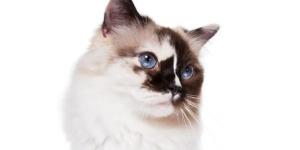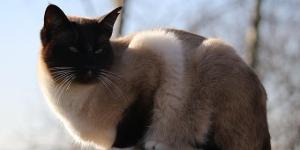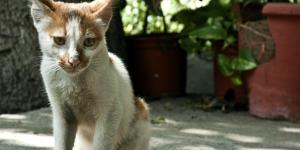Ceylon Cat

The Ceylon is a rare feline breed with the few specimens alive found in France and Italy. However, a process of breeding and selection is currently being carried out. Originally from Sri Lanka, they are an active, intelligent, affectionate and playful cat that adapts to different homes and gets along well with children. It is a strong and healthy breed, without hereditary diseases and a fine but robust, compact and muscular appearance. They have a characteristic small head with tabby pattern stripes on the forehead, pronounced cheekbones, almond-shaped eyes and large ears with rounded tips.
AnimalWised brings you everything you need to know about the Ceylon cat. We look the breed's origins, physical characteristics, temperament and more, including photos of the Ceylon cat breed.
- Asia
- Sri Lanka
- 7-11
- 11-13
- 13-17
- 17-22
- 22-30
- 8-10
- 10-15
- 15-18
- 18-20
Origin of the Ceylon cat
The Ceylon cat is an Asian cat breed that originates from a landrace breed from Sri Lanka, located in southeast of India. The beginning of these cats dates back to 1984 when an Italian doctor named Paolo Pellegatta found them in that area and was dazzled by the tabby markings on their heads, necks, legs and tails. It was then he took several specimens to his home in Milan, Italy, to start a breeding program.
In 1988 the Club de Amigos del Gatto di Celylon was created and in 1993 the the International Cat Association (TICA) first officially recognized the breed.
Characteristics of the Ceylon cat
The Ceylon cat is a medium-sized cat, with a height of 25-35 cm (10-14") and a weight of 3-5 kg (6.6-11 lb) in females and 4-6 kg (8.8-13 lb) in males. Its body is semi-cobby in shape, i.e. they have a compact and robust body, with a round and wide head. They have fine bones, but powerful muscles. The tail tapers as it reaches the tip and the front legs are somewhat shorter than the back.
The head is small in relation to the rest of the body. It is rounded with prominent cheeks, a nose without a naso-frontal depression, large ears with rounded tips that are lighter in color than the rest of the body, a flat forehead, a chin, strong jaws and large almond-shaped eyes that match the color of the coat, generally green or yellow.
Ceylon cat coat colors
The hair of these cats is short, fine and silky. It is very tight to the skin and they barely have an undercoat. One of the Ceylon cat characteristics that stands out the most is their coat pattern. They have a slight tabby pattern in certain areas such as the forehead, tail, legs and back. The tip of the tail is a slightly darker color than the rest of the fur, which can be of the following colors:
- Ash
- Gold
- Black
- Red
- Tortoise
- Blue
Take a look at our related article to see the different types of cats with tabby coats.
Ceylon cat temperament
The Ceylon cat has a calm, affectionate and independent temperament. They are somewhat shy with strangers, but very affectionate with their own family and love to be at home with their guardians, although they are not overly dependent. In addition, they get along very well with children and other animals. They adapt well to life inside a small apartment, but they are also a fan of the outdoors. They are an active and playful cat, always alert and fit.
Ceylon cat care
These short-haired cats, have no undercoat and their hair is short and tight to the body. They hardly shed, so a couple of weekly brushings is enough. Certain diseases can predispose these cats to ingest more hair than they should and their digestive elimination system is not as efficient as many other cats. For this reason, we must not forget this brushing routine, even in short-haired cats such as the Ceylon as it prevents hairballs.
Continuing with the care of the Ceylon cat breed, the large ears of this feline must be cleaned regularly to prevent otitis. Their teeth need to be brushed both to prevent tooth decay and detect diseases such as feline chronic gingivostomatitis, gingivitis, periodontal disease, fractures, infections or wounds. The eyes must also be cleaned of secretions and dirt to prevent infection.
Since they are active and playful cats, it is essential to guarantee environmental enrichment. They need to have scratching posts with various heights, a rest area, one or more litter trays (depending on whether there are more cats in the home), various toys, etc. Likewise, it is important to spend some time each day to play as they are cats that love to spend time with their human companions.
Finally, due to the nature of the species and the developed musculature of the breed, these cats must follow a diet with a high percentage of protein of animal origin for the maintenance of muscles, the obtaining of essential nutrients and the preservation of their health.
Ceylon cat health
The Ceylon cat has a life expectancy of 14-16 years. They are a cat that enjoys good health and no disease associated with the breed is known at the moment. However, as with any cat breed, they are at risk of any infectious and parasitic disease common in this species, so vaccination guidelines against diseases such as rhinotracheitis, calicivirus, leukemia and rabies, and deworming against internal and external parasites and the infectious diseases that they can carry, must be carried out. Likewise, these cats must undergo annual check-ups in order to detect any type of pathology early to have a better prognosis and effectiveness in treatment.
Where to adopt a Ceylon cat
Adopting a Ceylon cat is a very difficult task, especially outside the Asian areas of origin or where they are being bred, i.e. France and Italy. This is because there are very few specimens. It should be noted that any cat deserves a responsible adoption. If you are thinking of adopting a cat, we recommend going to a shelter to adopt a cat in need.
Ceylon Cat photos








